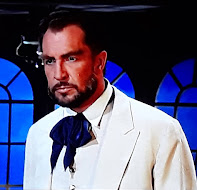 |
| Vincent Price as Robur. |
Jules Verne was a hot property in the late 1950s and 1960s, with movie theaters filled with big-budget adaptations of
Around the World in 80 Days (1956),
Journey to the Center of the Earth (1959), and
Mysterious Island (1961). So, it was inevitable that American International Pictures (AIP) would mount its own Verne extravaganza in 1961 starring Vincent Price. As AIP movies go,
Master of the World was a classier effort than usual with a literate script by Richard Matheson and decent special effects.
Set in 1868, it opens with the "eruption" of The Great Eyrie mountain in a small Pennsylvania town. John Strock, an agent for the Department of Interior, enlists the aid of two balloonists to investigate the mysterious incident (townsfolk also reported hearing the "voice of God"). As their balloon nears the mountain's crater, it is seemingly shot down from the sky and crashes.
Strock (Charles Bronson) and the others awaken aboard a flying fortress called The Albatross. The ship's commander is a pacifist called Robur (Vincent Price), who is willing to employ violence to bring peace to the world. He makes his intentions clear when--after warning a battleship to disarm--he destroys the ship and its crew. Can Strock stop Robur before others die in his path of destruction?
 |
| The flying fortress Albatross. |
Although based on two Verne novels,
Robur the Conqueror and its sequel
Master of the World, Matheson's screenplay bears more than a passing resemblance to Disney's
20,000 Leagues Under the Sea (1954). Both Robur and Captain Nemo want to end war, both live in fantastic vessels, and are threatened by survivors that they take aboard (portrayed by Bronson and Kirk Douglas, respectively). Whereas
20,000 Leagues employed a sea lion for comic relief,
Master of the World uses a French chef!
Also, while Disney's film was a technological marvel for its time, Master of the World has to make do with a modest budget. The special effects range from serviceable (e.g, the Albatross) to woeful (e.g., the flat painting of The Great Erie). Obvious stock footage, mostly from The Four Feathers (1939), is used extensively.
 |
| Charles Bronson as the hero. |
Vincent Price carries the film with his authoritative presence, whether playing the proud host to his guests or threatening war to end war. Bronson looks bored as the hero, but frankly it's not a well-written part. The rest of the cast includes Henry Hull as a balloonist (and arms manufacturer), Mary Webster as his adult daughter, and David Frankham as her hot-headed fiancé.
AIP considered making a Master of the World sequel at one point. Pre-production artwork exists for a movie titled Stratofin, which would have given Robur a new fantastical ship called The Terror. Alas, the idea was abandoned and we're left with this one and only outing with The Albatross.
Master of the World played frequently on local channels when I was a kid in the late 1960s and early 1970s. I hadn't seen for many years, though, until it popped up recently on a cable channel called ScreenPix.














